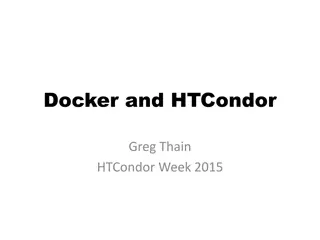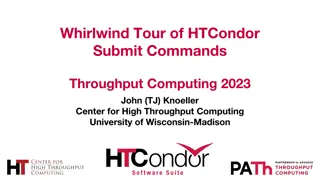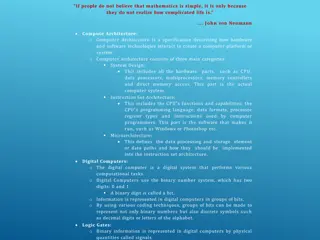Understanding HTCondor Administration Basics and Architecture
Explore the basics of HTCondor administration, architecture overview, setting up personal and distributed Condor systems, key abstractions, job and machine life cycles, and interactions between submit and execute sides. Learn about the components like condor_schedd, condor_shadow, and how jobs are processed in the HTCondor environment.
Download Presentation

Please find below an Image/Link to download the presentation.
The content on the website is provided AS IS for your information and personal use only. It may not be sold, licensed, or shared on other websites without obtaining consent from the author. Download presentation by click this link. If you encounter any issues during the download, it is possible that the publisher has removed the file from their server.
E N D
Presentation Transcript
HTCondor Administration Basics Greg Thain Center for High Throughput Computing
Overview HTCondor Architecture Overview Configuration and other nightmares Setting up a personal condor Setting up distributed condor Minor topics 2
Two Big HTCondor Abstractions Jobs Machines 3
Life cycle of HTCondor Job Held Complete Running Xfer out Xfer In Idle Submit file Suspend History file 4
Life cycle of HTCondor Machine collector negotiator schedd startd Schedd may split shadow Config file 5
Submit Side Held Complete Running Xfer out Xfer In Idle Submit file Suspend Suspend Suspend History file 6
Execute Side Held Complete Running Xfer out Xfer In Idle Submit file Suspend Suspend Suspend History file 7
The submit side Submit side managed by 1 condor_schedd process And one shadow per running job condor_shadow process The Schedd is a database Submit points can be performance bottleneck Usually a handful per pool 8
In the Beginning universe = vanilla executable = compute request_memory = 70M arguments = $(ProcID) should_transfer_input = yes output = out.$(ProcID) error = error.$(ProcId) +IsVerySpecialJob = true Queue HTCondor Submit file 9
From submit to schedd JobUniverse = 5 Cmd = compute Args = 0 RequestMemory = 70000000 Requirements = Opsys == Li.. DiskUsage = 0 Output = out.0 IsVerySpecialJob = true condor_submit submit_file Submit file in, Job classad out Sends to schedd man condor_submit for full details Other ways to talk to schedd Python bindings, SOAP, wrappers (like DAGman) 10
Condor_schedd holds all jobs JobUniverse = 5 Owner = gthain JobStatus = 1 NumJobStarts = 5 Cmd = compute Args = 0 RequestMemory = 70000000 Requirements = Opsys == Li.. DiskUsage = 0 Output = out.0 IsVerySpecialJob = true One pool, Many schedds condor_submit name chooses Owner Attribute: need authentication Schedd also called q not actually a queue 11
Condor_schedd has all jobs In memory (big) condor_q expensive And on disk Fsync s often Monitor with linux Attributes in manual condor_q -l job.id e.g. condor_q -l 5.0 JobUniverse = 5 Owner = gthain JobStatus = 1 NumJobStarts = 5 Cmd = compute Args = 0 RequestMemory = 70000000 Requirements = Opsys == Li.. DiskUsage = 0 Output = out.0 IsVerySpecialJob = true 12
What if I dont like those Attributes? Write a wrapper to condor_submit SUBMIT_ATTRS condor_qedit 13
ClassAds: The lingua franca of HTCondor 14
What are ClassAds? ClassAds is a language for objects (jobs and machines) to Express attributes about themselves Express what they require/desire in a match (similar to personal classified ads) Structure : Set of attribute name/value pairs, where the value can be a literal or an expression. Semi-structured, no fixed schema. 15
Example Buyer Ad AcctBalance = 100 DogLover = True Requirements = (Type == Dog ) && (TARGET.Price <= MY.AcctBalance) && ( Size == "Large" || Size == "Very Large" ) Rank = 100* (Breed == "Saint Bernard") - Price . . . Pet Ad Type = Dog Requirements = DogLover =?= True Color = Brown Price = 75 Sex = "Male" AgeWeeks = 8 Breed = "Saint Bernard" Size = "Very Large" Weight = 27 16
ClassAd Values Literals Strings ( RedHat6 ), integers, floats, boolean (true/false), Expressions Similar look to C/C++ or Java : operators, references, functions References: to other attributes in the same ad, or attributes in an ad that is a candidate for a match Operators: +, -, *, /, <, <=,>, >=, ==, !=, &&, and || all work as expected Built-in Functions: if/then/else, string manipulation, regular expression pattern matching, list operations, dates, randomization, math (ceil, floor, quantize, ), time functions, eval, 17 17
Four-valued logic ClassAd Boolean expressions can return four values: True False Undefined (a reference can t be found) Error (Can t be evaluated) Undefined enables explicit policy statements in the absence of data (common across administrative domains) Special meta-equals ( =?= ) and meta-not-equals (=!=) will never return Undefined [ HasBeer = True GoodPub1 = HasBeer == True GoodPub2 = HasBeer =?= True ] [ GoodPub1 = HasBeer == True GoodPub2 = HasBeer =?= True ]
ClassAd Types HTCondor has many types of ClassAds A "Job Ad" represents a job to Condor A "Machine Ad" represents a computing resource Others types of ads represent other instances of other services (daemons), users, accounting records. 19
The Magic of Matchmaking Two ClassAds can be matched via special attributes: Requirements and Rank Two ads match if both their Requirements expressions evaluate to True Rank evaluates to a float where higher is preferred; specifies the which match is desired if several ads meet the Requirements. Scoping of attribute references when matching MY.name Value for attribute name in local ClassAd TARGET.name Value for attribute name in match candidate ClassAd Name Looks for name in the local ClassAd, then the candidate ClassAd 20
Example Buyer Ad AcctBalance = 100 DogLover = True Requirements = (Type == Dog ) && (TARGET.Price <= MY.AcctBalance) && ( Size == "Large" || Size == "Very Large" ) Rank = 100* (Breed == "Saint Bernard") - Price . . . Pet Ad Type = Dog Requirements = DogLover =?= True Color = Brown Price = 75 Sex = "Male" AgeWeeks = 8 Breed = "Saint Bernard" Size = "Very Large" Weight = 27 21
Configuration of Submit side Not much policy to be configured in schedd Mainly scalability and security MAX_JOBS_RUNNING JOB_START_DELAY MAX_CONCURRENT_DOWNLOADS MAX_JOBS_SUBMITTED 23
The Execute Side Primarily managed by condor_startd process With one condor_starter per running jobs Sandboxes the jobs Usually many per pool (support 10s of thousands) 24
Startd also has a classad Condor makes it up From interrogating the machine And the config file And sends it to the collector condor_status [-l] Shows the ad condor_status direct daemon Goes to the startd 25
Condor_status l machine OpSys = "LINUX CustomGregAttribute = BLUE OpSysAndVer = "RedHat6" TotalDisk = 12349004 Requirements = ( START ) UidDomain = cheesee.cs.wisc.edu" Arch = "X86_64" StartdIpAddr = "<128.105.14.141:36713>" RecentDaemonCoreDutyCycle = 0.000021 Disk = 12349004 Name = "slot1@chevre.cs.wisc.edu" State = "Unclaimed" Start = true Cpus = 32 Memory = 81920 26
One Startd, Many slots HTCondor treats multicore as independent slots Start can be configured to: Only run jobs based on machine state Only run jobs based on other jobs running Preempt or Evict jobs based on policy A whole talk just on this 27
Configuration of startd Mostly policy, whole talk on that Several directory parameters EXECUTE where the sandbox is CLAIM_WORKLIFE How long to reuse a claim for different jobs 28
The Middle side There s also a Middle , the Central Manager: A condor_negotiator Provisions machines to schedds A condor_collector Central nameservice: like LDAP condor_status queries this Please don t call this Master node or head Not the bottleneck you may think: stateless 29
Responsibilities of CM Pool-wide scheduling policy resides here Scheduling of one user vs another Definition of groups of users Definition of preemption 30
The condor_master Every condor machine needs a master Like systemd , or init Starts daemons, restarts crashed daemons Tunes machine for condor 31
Quick Review of Daemons condor_master: runs on all machine, always condor_schedd: runs on submit machine condor_shadow: one per job condor_startd: runs on execute machine condor_starter: one per job condor_negotiator/condor_collector 32
Process View condor_master (pid: 1740) condor_procd fork/exec Condor Kernel condor_schedd condor_q condor_submit Tools fork/exec condor_shadow condor_shadow condor_shadow Condor Userspace 33
Process View: Execute condor_master (pid: 1740) condor_procd fork/exec Condor Kernel condor_startd condor_status -direct Tools condor_starter condor_starter condor_starter Condor Userspace Job Job Job 34
Process View: Central Manager condor_master (pid: 1740) Condor Kernel condor_procd fork/exec condor_collector condor_negotiator condor_userprio Tools 35
Lets Install HTCondor Either with tarball tar xvf htcondor-8.2.3-redhat6 Or native packages wget http://research.cs.wisc.edu/htcondor/yum/repo.d/h tcondor-stable-rhel6.repo get http://research.cs.wisc.edu/htcondor/yum/RPM- GPG-KEY-HTCondor rpm import RPM_GPG-KEY-HTCondor Yum install htcondor 37
Version Number Scheme Major.minor.release If minor is even (a.b.c): Stable series Very stable, mostly bug fixes Current: 8.4 Examples: 8.2.5, 8.0.3 8.6.0 coming soon to a repo near you If minor is odd (a.b.c): Developer series New features, may have some bugs Current: 8.5 Examples: 8.3.2, 8.5.5 almost released 38
The Guarantee All minor releases in a stable series interoperate E.g. can have pool with 8.4.0, 8.4.1, etc. But not WITHIN A MACHINE: Only across machines The Reality We work really hard to do better 8.4 with 8.2 with 8.5, etc. Part of HTC ideal: can never upgrade in lock-step 39
Lets Make a Pool First need to configure HTCondor 1100+ knobs and parameters! Don t need to set all of them 41
Default file locations BIN = /usr/bin SBIN = /usr/sbin LOG = /var/condor/log SPOOL = /var/lib/condor/spool EXECUTE = /var/lib/condor/execute CONDOR_CONFIG = /etc/condor/condor_config 42
Configuration File (Almost)all configure is in files, root CONDOR_CONFIG env var /etc/condor/condor_config This file points to others All daemons share same configuration Might want to share between all machines (NFS, automated copies, puppet, etc) 43
Configuration File Syntax # I m a comment! CREATE_CORE_FILES=TRUE MAX_JOBS_RUNNING = 50 # HTCondor ignores case: log=/var/log/condor # Long entries: collector_host=condor.cs.wisc.edu,\ secondary.cs.wisc.edu 44
Other Configuration Files LOCAL_CONFIG_FILE Comma separated, processed in order LOCAL_CONFIG_FILE = \ /var/condor/config.local,\ /shared/condor/config.$(OPSYS) LOCAL_CONFIG_DIR Files processed IN LEXIGRAPHIC ORDER LOCAL_CONFIG_DIR = \ /etc/condor/config.d 45
Configuration File Macros You reference other macros (settings) with: A = $(B) SCHEDD = $(SBIN)/condor_schedd Can create additional macros for organizational purposes 46
Configuration File Macros Can append to macros: A=abc A=$(A),def Don t let macros recursively define each other! A=$(B) B=$(A) 47
Configuration File Macros Later macros in a file overwrite earlier ones B will evaluate to 2: A=1 B=$(A) A=2 48
Config file defaults CONDOR_CONFIG root config file: /etc/condor/condor_config Local config file: /etc/condor/condor_config.local Config directory /etc/condor/config.d 49
Config file recommendations For system condor, use default Global config file read-only /etc/condor/condor_config All changes in config.d small snippets /etc/condor/config.d/05some_example All files begin with 2 digit numbers Personal condors elsewhere 50

















































